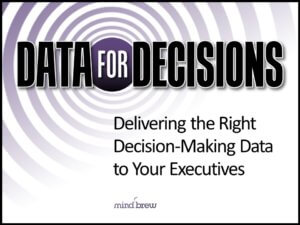In today’s fast-paced business environment, where decision-making often occurs at breakneck speeds, one particular tendency we see all-too-often is the ‘just do something!’ mentality or action bias. This dynamic typically manifests when there’s some sort of a negative surprise, like a big missed target or an unexpected market turn or economic shock.
See if this scenario has a familiar ring to it…
You’re in a quarterly review session, and the data being presented is ugly; really ugly. The commercial team’s performance is well below target, or a recent market disruption has thrown things way off course. The room fills with an uncomfortable sense of urgency, fear, and anxiety. As a stakeholder and functional lead, you feel your pulse increase and your mind races to spin up potential solutions.
Everything about the situation is screaming, “We need to do something! And we need to do it yesterday!”
Over many thousands of years, we humans have been wired toward rapid action in moments of perceived crisis or threat—run, hide, fight! This engrained human instinct is what forms the cornerstone of the action bias. And while it may seem beneficial at first glance…hey, who wouldn’t want the most proactive team possible?…there are a number of risks that can far outweigh the benefits when the action bias is allowed to roam free.
First off, the action bias can lead to “fixing” things that aren’t actually broken.
In the race to ‘do something,’ we often fail to conduct a thorough diagnostic analysis of the situation to determine the true nature of the problem. Is something broken internally, or is this external for the most part? Are we uniquely affected or is everyone in the same boat? Do we expect the situation to be temporary or will it extend for a longer period of time? Do we have any evidence that changing things will actually improve the situation?
Secondly, decisions made in haste will almost always produce some number of unintended consequences.
When we act without fully understanding the problem at hand or without considering the broader implications of our actions, we may inadvertently disrupt other important aspects of our operations. These ill-considered actions can then cascade throughout our organization, causing unforeseen complications and creating a whole host of new problems. And then a vicious cycle gets underway as these all new problems then demand even more hasty ‘solutions’.
So, if the ‘just do something’ mentality is fraught with danger, what’s the alternative? Well, here’s where we run into a bit of a conundrum…
In response to a crisis or surprise, doing absolutely nothing may in fact be the best course of action…or inaction, if you prefer. That said, doing nothing in the face of a perceived crisis is entirely contrary to human nature. And as everyone else in your organization is presumably human, the “wait and see” or “do nothing” notions are not likely to be very popular.
Worse yet, you yourself may not be looked upon very favorably for even suggesting such nonchalant approaches! How could you be so indifferent!? Where’s your sense of urgency?!? Don’t you see what’s happening?!? Don’t you care?!!
Here again…as is so often the case…the answer to this conundrum lies in directing human nature rather than fighting against it.
It’s human nature to want to take rapid action in response to a perceived crisis or negative surprise. Ok. Fine. But let’s focus those rapid actions toward these types of much more productive and appropriate activities and exercises:
- Thoroughly assessing the situation, understanding the true nature of the problems, and diagnosing the underlying root causes.
- Working through the potential implications and ramifications of various responses and approaches (including doing nothing).
- Assembling and analyzing all of the situational data necessary to better inform management’s perceptions and decisions.
You see, the biggest problem with the action bias is not really the bias; it’s the action. In other words, the engrained desire to take rapid action in a crisis only becomes a major problem when the actions are ill-considered and/or counter-productive.
And so, by directing or channeling that engrained desire to take action toward things like situational assessment and analysis, we can reap most of the benefits of rapid action while at the same time, avoiding the most costly downsides associated knee-jerk solutions and hasty changes.
















